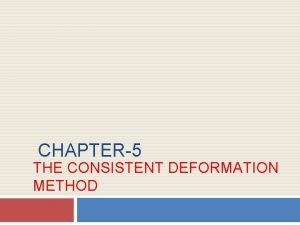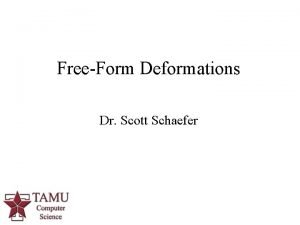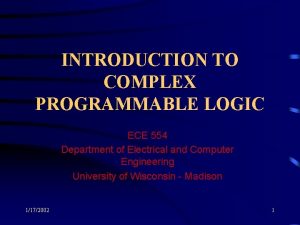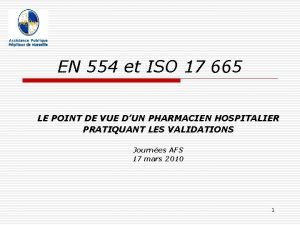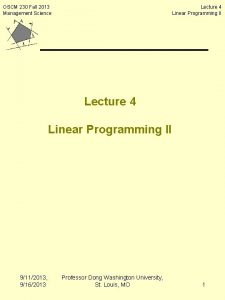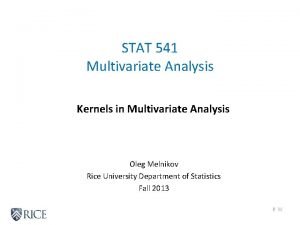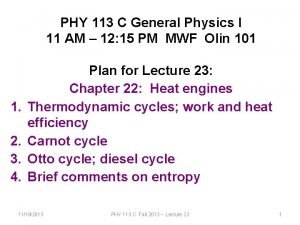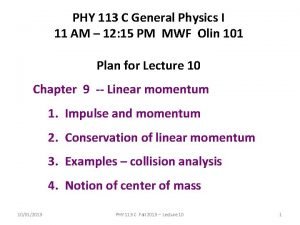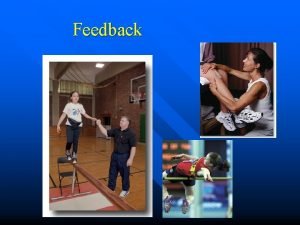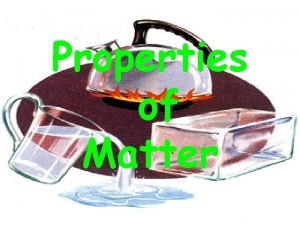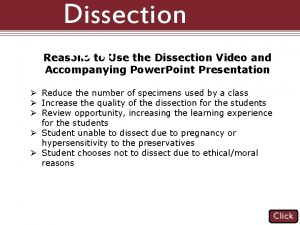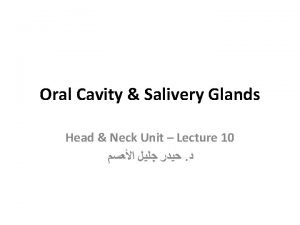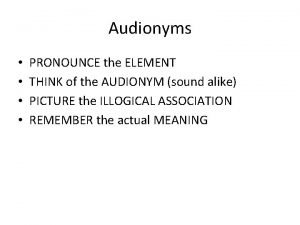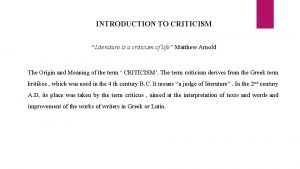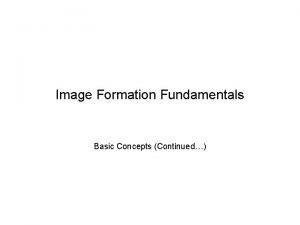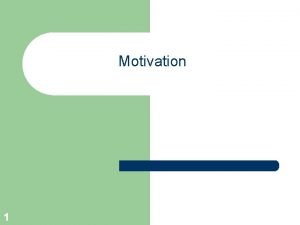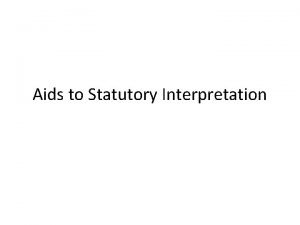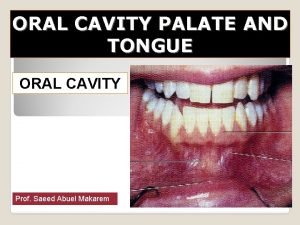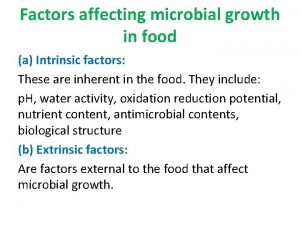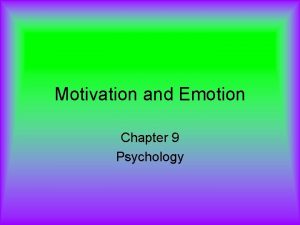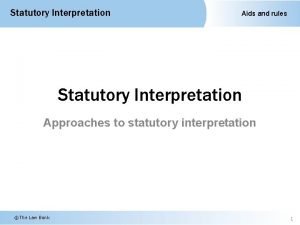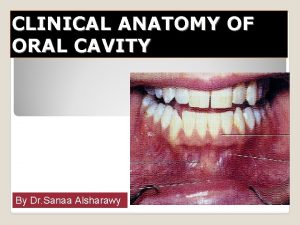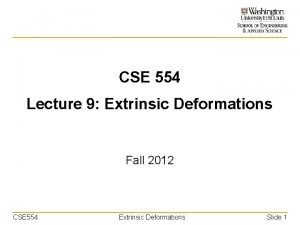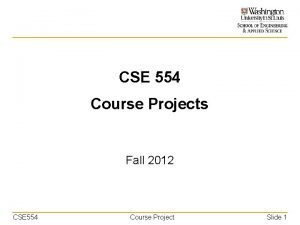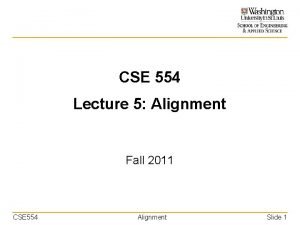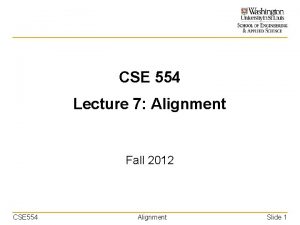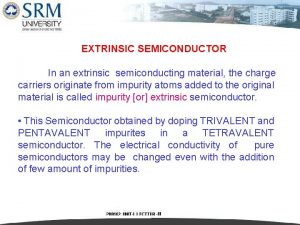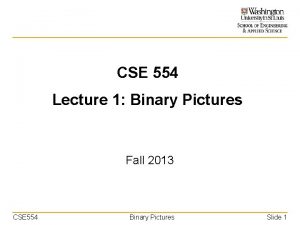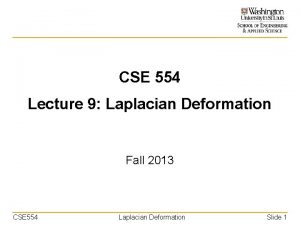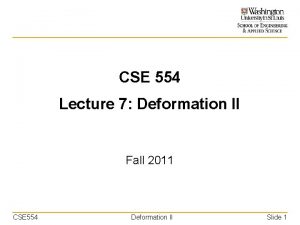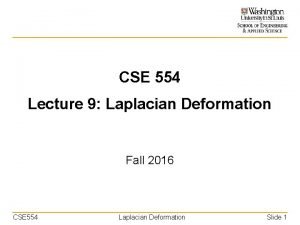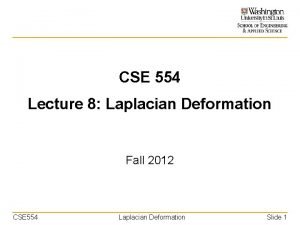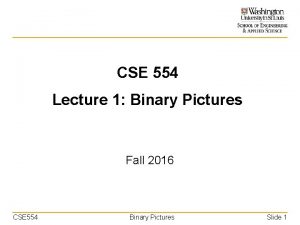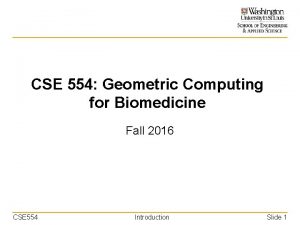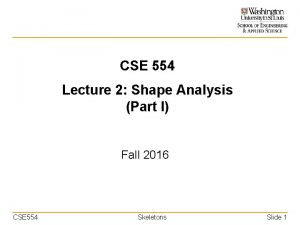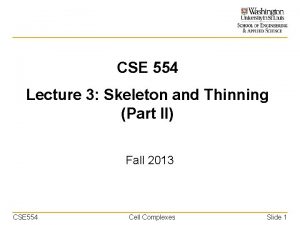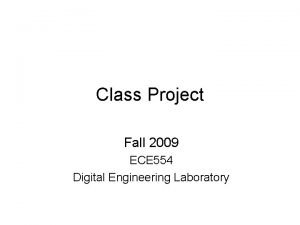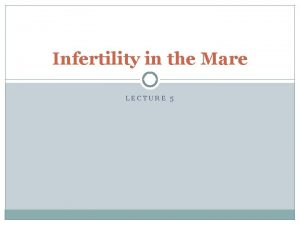CSE 554 Lecture 10 Extrinsic Deformations Fall 2013

















![Free Form Deformation • Desirable properties of the weights wi[p] – Greater when p Free Form Deformation • Desirable properties of the weights wi[p] – Greater when p](https://slidetodoc.com/presentation_image_h/a9466b0647ef1bdef4366816ebcaab30/image-18.jpg)














- Slides: 32

CSE 554 Lecture 10: Extrinsic Deformations Fall 2013 CSE 554 Extrinsic Deformations Slide 1

Review Source • Non-rigid deformation – Intrinsic methods: deforming the boundary points – An optimization problem Target Before • Minimize shape distortion • Maximize fit – Example: Laplacian-based deformation CSE 554 After Extrinsic Deformations Slide 2

Extrinsic Deformation • Computing deformation of each point in the plane or volume – Not just points on the boundary curve or surface Credits: Adams and Nistri, BMC Evolutionary Biology (2010) CSE 554 Extrinsic Deformations Slide 3

Extrinsic Deformation • Applications – Registering contents between images and volumes – Interactive spatial deformation CSE 554 Extrinsic Deformations Slide 4

Techniques • Thin-plate spline deformation • Free form deformation • Cage-based deformation CSE 554 Extrinsic Deformations Slide 5

Thin-Plate Spline • Given corresponding source and target points • Computes a spatial deformation function for every point in the 2 D plane or 3 D volume Credits: Sprengel et al, EMBS (1996) CSE 554 Extrinsic Deformations Slide 6

Thin-Plate Spline • A minimization problem – Minimizing distances between source and target points – Minimizing distortion of the space (as if bending a thin sheet of metal) • There is a closed-form solution – Solving a linear system of equations CSE 554 Extrinsic Deformations Slide 7

Thin-Plate Spline • Input pi qi – Source points: p 1, …, pn – Target points: q 1, …, qn • Output p – A deformation function f[p] for any point p f[p] CSE 554 Extrinsic Deformations Slide 8

Thin-Plate Spline • Minimization formulation – Ef: fitting term • Measures how close is the deformed source to the target – Ed: distortion term • Measures how much the space is warped – : weight • Controls how much non-rigid warping is allowed CSE 554 Extrinsic Deformations Slide 9

Thin-Plate Spline • Fitting term – Minimizing sum of squared distances between deformed source points and target points CSE 554 Extrinsic Deformations Slide 10

Thin-Plate Spline • Distortion term – Minimizing a physical bending energy on a metal sheet (2 D): – The energy is zero when the deformation is affine • Translation, rotation, scaling, shearing CSE 554 Extrinsic Deformations Slide 11

Thin-Plate Spline • Finding the minimizer for – Uniquely exists, and has a closed form: where • M: an affine transformation matrix • vi: translation vectors (one per source point) • Both M and vi are determined by pi, qi, CSE 554 Extrinsic Deformations Slide 12

Thin-Plate Spline • Result – At higher , the deformation is closer to an affine transformation Credits: Sprengel et al, EMBS (1996) CSE 554 Extrinsic Deformations Slide 13

Thin-Plate Spline • Application: landmark-based image registration – Manual or automatic detection of landmarks and correspondences Source Target Deformed source Credits: Rohr et al, TMI (2001) CSE 554 Extrinsic Deformations Slide 14

Free Form Deformation • Uses a control lattice that embeds the shape • Deforming the lattice points warps the embedded shape Credits: Sederberg and Parry, SIGGRAPH (1986) CSE 554 Extrinsic Deformations Slide 15

Free Form Deformation • Warping the space by “blending” the deformation at the control points – Each deformed point is a weighted sum of deformed lattice points CSE 554 Extrinsic Deformations Slide 16

Free Form Deformation • Input – Source lattice points: p 1, …, pn – Target lattice points: q 1, …, qn • Output – A deformation function f[p] for any p f[p] point p in the lattice grid. pi qi • wi[p]: pre-computed “influence” of pi on p CSE 554 Extrinsic Deformations Slide 17
![Free Form Deformation Desirable properties of the weights wip Greater when p Free Form Deformation • Desirable properties of the weights wi[p] – Greater when p](https://slidetodoc.com/presentation_image_h/a9466b0647ef1bdef4366816ebcaab30/image-18.jpg)
Free Form Deformation • Desirable properties of the weights wi[p] – Greater when p is closer to pi • So that the influence of each control point is local – Smoothly varies with location of p • So that the deformation is smooth p f[p] – • So that f[p] = wi[p] qi is an affine combination of qi pi qi – • So that f[p]=p if the lattice stays unchanged CSE 554 Extrinsic Deformations Slide 18

Free Form Deformation • Finding weights (2 D) – Let the lattice points be pi, j for i=0, …, k and j=0, …, l – Compute p’s relative location in the grid (s, t) • Let (xmin, xmax), (ymin, ymax) be the range of grid p 0, 2 t p 1, 2 p 2, 2 p 3, 2 p p 0, 1 p 1, 1 p 2, 1 p 3, 1 p 0, 0 p 1, 0 p 2, 0 p 3, 0 s CSE 554 Extrinsic Deformations Slide 19

Free Form Deformation • Finding weights (2 D) – Let the lattice points be pi, j for i=0, …, k and j=0, …, l – Compute p’s relative location in the grid (s, t) – The weight wi, j for lattice point pi, j is: p 0, 2 t p 1, 2 p 2, 2 p 3, 2 p p 0, 1 p 1, 1 p 2, 1 p 3, 1 p 0, 0 p 1, 0 p 2, 0 p 3, 0 s • i, j: importance of pi, j • B: Bernstein basis function: CSE 554 Extrinsic Deformations Slide 20

Free Form Deformation • Finding weights (2 D) – Weight distribution for one control point (max at that control point): p 3, 2 p 3, 1 p 1, 1 p 0, 2 p 3, 0 p 0, 1 p 2, 0 p 1, 0 p 0, 0 CSE 554 Extrinsic Deformations Slide 21

Free Form Deformation • A deformation example CSE 554 Extrinsic Deformations Slide 22

Free Form Deformation • Image registration – Embed the source in a lattice – Compute new lattice positions over the target • Manually, or solve it as an optimization problem (maximally matching images contents while minimizing distortion) – Deform each source pixel using FFD www. slicer. org CSE 554 Extrinsic Deformations Slide 23

Cage-based Deformation • Use a control mesh (“cage”) to embed the shape • Deforming the cage vertices warps the embedded shape Credits: Ju, Schaefer, and Warren, SIGGRAPH (2005) CSE 554 Extrinsic Deformations Slide 24

Cage-based Deformation • Warping the space by “blending” the deformation at the cage vertices pi p – wi[p]: pre-computed “influence” of pi on p f[p] CSE 554 Extrinsic Deformations qi Slide 25

Cage-based Deformation • Finding weights (2 D) – Problem: given a closed polygon (cage) with vertices pi and an interior point p, find smooth weights wi[p] such that: • 1) pi • 2) CSE 554 p Extrinsic Deformations Slide 26

Cage-based Deformation • Finding weights (2 D) – A simple case: the cage is a triangle – The weights are unique (3 eqs, 3 vars) p 1 p – Known as the barycentric coordinates of p p 3 p 2 CSE 554 Extrinsic Deformations Slide 27

Cage-based Deformation • Finding weights (2 D) – The harder case: the cage is an arbitrary (possibly concave) polygon – The weights are not unique • A good choice: Mean Value Coordinates (MVC) • Can be extended to 3 D pi-1 pi αi p αi+1 pi+1 CSE 554 Extrinsic Deformations Slide 28

Cage-based Deformation • Finding weights (2 D) – Weight distribution of one cage vertex in MVC: pi CSE 554 Extrinsic Deformations Slide 29

Cage-based Deformation • Application: character animation CSE 554 Extrinsic Deformations Slide 30

Cage-based Deformation • Registration – Embed source in a cage – Compute new locations of cage vertices over the target • Minimizing some fitting and energy objectives – Deform source pixels using MVC • Not seen in literature yet… future work! CSE 554 Extrinsic Deformations Slide 31

Further Readings • Thin-plate spline deformation – “Principal warps: thin-plate splines and the decomposition of deformations”, by Bookstein (1989) – “Landmark-Based Elastic Registration Using Approximating Thin-Plate Splines”, by Rohr et al. (2001) • Free form deformation – “Free-Form Deformation of Solid Geometric Models”, by Sederberg and Parry (1986) – “Extended Free-Form Deformation: A sculpturing Tool for 3 D Geometric Modeling”, by Coquillart (1990) • Cage-based deformation – “Mean value coordinates for closed triangular meshes”, by Ju et al. (2005) – “Harmonic coordinates for character animation”, by Joshi et al. (2007) – “Green coordinates”, by Lipman et al. (2008) CSE 554 Extrinsic Deformations Slide 32
 Consistent deformation method for beams examples
Consistent deformation method for beams examples Deformations
Deformations Ece 554 uw madison
Ece 554 uw madison En 554
En 554 554 romeinse cijfers
554 romeinse cijfers 01:640:244 lecture notes - lecture 15: plat, idah, farad
01:640:244 lecture notes - lecture 15: plat, idah, farad Fall 2013
Fall 2013 Fall 2013
Fall 2013 Fall 2013
Fall 2013 Fall 2013
Fall 2013 Define augmented feedback
Define augmented feedback Is luster intrinsic or extrinsic
Is luster intrinsic or extrinsic Ethos, pathos, logos, kairos examples
Ethos, pathos, logos, kairos examples Ciliary body cow eye
Ciliary body cow eye Floor of mouth anatomy
Floor of mouth anatomy What is an audionym
What is an audionym Extrinsic rewards
Extrinsic rewards What is expressive criticism
What is expressive criticism Motivational cycle
Motivational cycle Semiconductor conductivity vs temperature
Semiconductor conductivity vs temperature Genioglossus innervation
Genioglossus innervation Courstey
Courstey Extrinsic hemolytic anemia
Extrinsic hemolytic anemia Lintrinsic
Lintrinsic Extrinsic and intrinsic aids to statutory interpretation
Extrinsic and intrinsic aids to statutory interpretation Mylohyoid
Mylohyoid Extrinsic rewards
Extrinsic rewards What are intrinsic factors for microbial growth
What are intrinsic factors for microbial growth Carroll izard 10 basic emotions
Carroll izard 10 basic emotions Muir v keay
Muir v keay Intrinsic and extrinsic character traits
Intrinsic and extrinsic character traits Sensory supply of soft palate
Sensory supply of soft palate What is extrinsic elements
What is extrinsic elements
